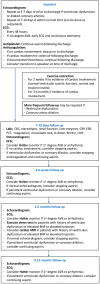Cardiac manifestations in SARS-CoV-2-associated multisystem inflammatory syndrome in children: a comprehensive review and proposed clinical approach
- PMID: 32803422
- PMCID: PMC7429125
- DOI: 10.1007/s00431-020-03766-6
Cardiac manifestations in SARS-CoV-2-associated multisystem inflammatory syndrome in children: a comprehensive review and proposed clinical approach
Abstract
Initial reports on COVID-19 described children as largely spared from severe manifestations, with only 2-6% of children requiring intensive care treatment. However, since mid-April 2020, clusters of pediatric cases of severe systemic hyperinflammation and shock epidemiologically linked with COVID-19 have been reported. This condition was named as SARS-Cov-2-associated multisystem inflammatory syndrome in children and showed similarities to Kawasaki disease. Here, we present a narrative review of cases reported in literature and we discuss the clinical acute and follow-up management of these patients. Patients with SARS-Cov-2-associated multisystem inflammatory syndrome frequently presented with persistent fever, gastrointestinal symptoms, polymorphic rash, conjunctivitis, and mucosal changes. Elevated inflammatory markers and evidence of cytokine storm were frequently observed. A subset of these patients also presented with hypotension and shock (20-100%) from either acute myocardial dysfunction or systemic hyperinflammation/vasodilation. Coronary artery dilation or aneurysms have been described in 6-24%, and arrhythmias in 7-60%. Cardiac support, immunomodulation, and anticoagulation are the key aspects for the management of the acute phase. Long-term structured follow-up of these patients is required due to the unclear prognosis and risk of progression of cardiac manifestations.Conclusion: Multisystem inflammatory syndrome is a novel syndrome related to SARS-CoV-2 infection. Evidence is still scarce but rapidly emerging in the literature. Cardiac manifestations are frequent, including myocardial and coronary involvement, and need to be carefully identified and monitored over time. What is Known: • Multisystem inflammatory syndrome in children (MIS-C) has been described associated with SARS-CoV-2. What is New: • Patients with MIS-C often present with fever, gastrointestinal symptoms, and shock. • Cardiac involvement is found in a high proportion of these patients, including ventricular dysfunction, coronary artery dilation or aneurysm, and arrhythmias. • Management is based on expert consensus and includes cardiac support, immunomodulatory agents, and anticoagulation. • Long-term follow-up is required due to the unclear prognosis and risk of progression of cardiac manifestation.
Keywords: COVID-19, SARS-CoV-2; Cardiac involvement; Coronary aneurysm; Multisystem inflammatory syndrome in children; Myocardial dysfunction.
Conflict of interest statement
The authors declare that they have no conflict of interest.
Figures
Comment in
-
Dicrotic Pulse Revisited in the Pandemic Context.Pediatr Cardiol. 2021 Oct;42(7):1658-1659. doi: 10.1007/s00246-021-02702-1. Epub 2021 Aug 8. Pediatr Cardiol. 2021. PMID: 34368920 Free PMC article. No abstract available.
References
Publication types
MeSH terms
Supplementary concepts
LinkOut - more resources
Full Text Sources
Medical
Miscellaneous


